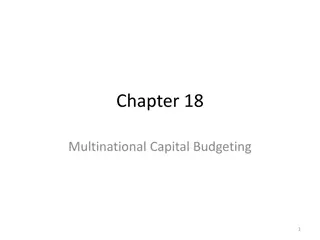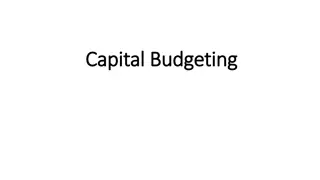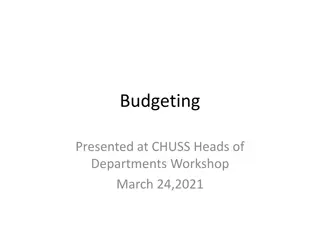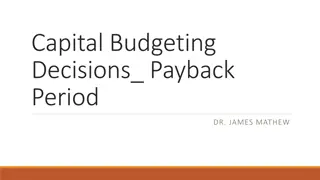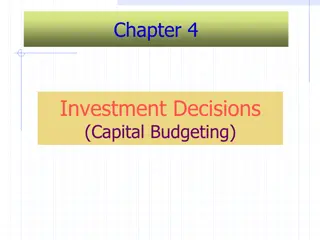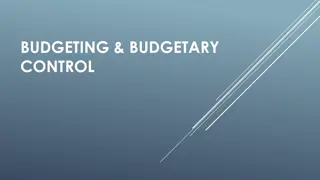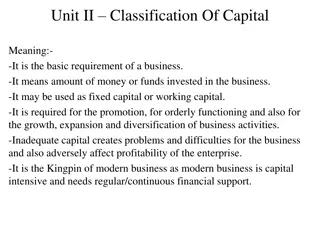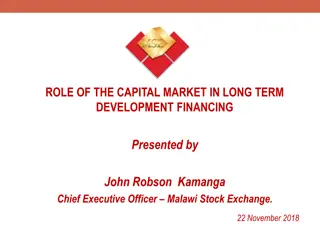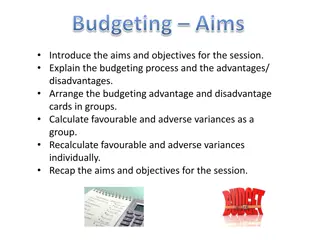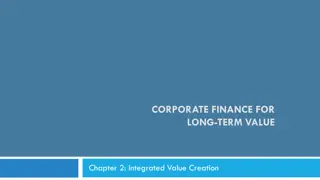Effective Capital Budgeting Strategies for Long-Term Value Creation
Understanding the capital budgeting process is crucial for selecting investment projects that align with long-term value creation goals. This involves calculating cash flows, discount rates, and valuation methods to evaluate projects based on financial, social, and environmental dimensions. Estimating future cash flows by analyzing line items and value drivers helps in making informed investment decisions.
Download Presentation

Please find below an Image/Link to download the presentation.
The content on the website is provided AS IS for your information and personal use only. It may not be sold, licensed, or shared on other websites without obtaining consent from the author.If you encounter any issues during the download, it is possible that the publisher has removed the file from their server.
You are allowed to download the files provided on this website for personal or commercial use, subject to the condition that they are used lawfully. All files are the property of their respective owners.
The content on the website is provided AS IS for your information and personal use only. It may not be sold, licensed, or shared on other websites without obtaining consent from the author.
E N D
Presentation Transcript
CORPORATE FINANCE FOR LONG-TERM VALUE Chapter 7: Capital budgeting
Part 2: Discount rates and valuation methods Chapter 7: Capital budgeting
The BIG Picture 3 How to select investment projects in practice -> capital budgeting Capital budgeting Calculate and compare the value of projects Integrate SV and EV into project evaluation Balance the financial, social and environmental dimensions of projects Critically evaluate projects in terms of company valuation profile
The capital budgeting process 4 1. Bottom-up identification of investment opportunities 2. Potential projects are collected centrally 3. Initial assessment of the projects on financial and non- financial criteria 4. Deep analysis including DCF done for a subset of investments Focus of this chapter 5. Some investments are chosen 6. Execution, monitoring & review
Calculating cash flows 5 The discounted cash flow (DCF) model calculates a project/company s Net Present Value (NPV): Year Cash flow Discount factor PV(Cash flow) NPV 2022 -100 1.00 -100.0 21.7 2023 25 0.91 22.7 2024 25 0.83 20.7 2025 25 0.75 18.8 2026 25 0.68 17.1 2027 25 0.62 15.5 2028 25 0.56 14.1 2029 25 0.51 12.8 Cash flows are calculated using: EBIT: earnings before interest and taxes CAPEX: capital expenditures i.e. company investments NWC: net working capital the difference between current assets and current liabilities
Calculating cash flows 6 Year Sales Costs (including depreciation) EBIT = sales - total costs Interest paid x applicable corporate tax rate Corporate tax Net income = EBIT - interest - corporate tax + depreciation - CAPEX - increase in NWC Project Cash Flows 2018 0 -472 -472 -10 25% 121 -362 48 -516 -12 -842 2019 320 -501 -181 -12 25% 48 -145 48 -37 -14 -148 2020 633 -512 121 -10 25% -28 83 48 -37 -24 70 2021 1196 -855 341 -8 25% -83 250 48 -37 -37 224 Note that corporate tax is first positive (tax refund) and later negative (tax paid)
Estimating future cash flows 7 Determining future cash flows requires estimates on individual line-items and their underlying value drivers Year 1 n/a n/a 0 n/a -100 -100 n/a 25% 25 -75 100 Year 2 n/a n/a 0 n/a -100 -100 n/a 25% 25 -75 100 Year 3 50 8,000 400 -7,000 -350 50 13% 25% -13 38 100 Year 4 120 8,000 960 -5,000 -600 360 38% 25% -90 270 100 Year 5 130 8,000 1,040 -4,200 -546 494 48% 25% -124 371 100 Year 6 140 8,000 1,120 -4,200 -588 532 48% 25% -133 399 100 .. Year 10 140 8,000 1,120 -4,200 -588 532 48% 25% -133 399 100 Volume (thousands of tonnes) Price (USD/tonne) Sales (USD million) Costs per tonne Costs (USD million) EBIT = sales - total costs EBIT margin x applicable corporate tax rate Corporate tax Net income = EBIT - corporate tax + depreciation - CAPEX - increase in NWC Project Cash Flows -600 -20 -595 -700 -20 -695 -400 -20 -283 -60 -20 290 -60 -20 391 -60 -20 419 -60 -20 419
Terminal value 8 If cash flows are expected to run for more years (i.e. 30), then you can calculate the annuity from the last estimated year (in this case year 10) using a constant cost of capital: Assume constant cash flows of 419 for 20 years (from year 11 to 30) with a cost of capital of 11% ?? =?? 1 419 0.11 1 1 ? 1 1+??= 1+0.1120= 3,809.1 1 0.124 = 3,336.8 Year 1 -595 Year 2 -695 Year 3 -283 Year 4 290 Year 5 391 Year 6 419 Year 7 419 Year 8 419 Year 9 419 Year 10 419 3,337 3,756 0.352 1,323 Project cash flows Terminal value Total cash flows Discount factor Present value NPV -595 0.901 -536 1,210 -695 0.812 -564 -283 0.731 -207 290 0.659 191 391 0.593 232 419 0.535 224 419 0.482 202 419 0.434 182 419 0.391 164
Forecasting assumptions 9 Year 0 n/a n/a 25% n/a n/a n/a Year 1 n/a -50% 25% 33% 17% 3% Year 2 167% 31% 25% 13% 6% 1% Year 3 5% 31% 25% 12% 8% 1% Year 4 5% 31% 25% 11% 8% 1% Extrapolated assumptions Year 5 5% 31% 25% 10% 8% 1% Year 6 5% 31% 25% 9% 8% 1% Year 7 5% 31% 25% 8% 8% 1% Sales growth EBIT margin Corporate tax rate Depreciation/sales CAPEX/sales Increase in NWC/sales Calculated on given data Detailed High-level Year 0 0 -10 -10 25% 3 -8 10 -70 -1 -69 1.000 -69 15 Year 1 30 -45 -15 25% 4 -11 10 -5 -1 -7 0.917 -7 Year 2 80 -55 25 25% -6 19 10 -5 -1 23 0.842 19 Year 3 84 -58 26 25% -7 20 10 -7 -1 21 0.772 17 Year 4 88 -61 27 25% -7 21 9 -7 -1 22 0.708 15 Year 5 93 -64 29 25% -7 22 9 -7 -1 22 0.650 14 Year 6 97 -67 30 25% -8 23 8 -8 -1 22 0.596 13 Year 7 102 -70 32 25% -8 24 8 -8 -1 22 0.547 12 Sales Costs EBIT x applicable tax rate Corporate tax Net income + depreciation - CAPEX - increase in NWC Project Cash Flows Discount factor Present value NPV
Incremental cash flows 10 Investment assessment is about changes to the current situation If a project creates new cash flows - but at the same time reduces the cash flows on ongoing projects - the net effect should be calculated (i.e. the incremental cash flows) Incremental cash flows reflect the difference in the company s overall cash flows with and without the project Cannibalisation: if a new product has superior characteristics compared to the existing product, then clients will switch and buy the new product instead of the existing one Opportunity cost of the project: missed value of what could have been done instead
Incremental cash flows 11 Product A before introduction product B 1,000 Product A after introduction product B 850 Change in product A Incremental cash flows of product B Product B -150 1,200 Sales 1,050 -700 -620 80 -800 Costs -720 300 230 -70 400 EBIT 330 30% 27% -3% 33% EBIT margin 31% x applicable tax rate 25% 25% 0% 25% 25% Corporate tax -75 -58 18 -100 -83 225 173 -53 300 Net income 248 + depreciation 50 50 0 100 100 - CAPEX -50 -40 10 100 110 - increase in NWC -20 -20 0 -30 -30 205 163 -43 470 Total Cash Flows 428 Should project B be done? Yes, incremental cash flows > 0
Including opportunity costs 12 Case: the water stress of a project is so severe that it puts drinking water quality and availability for the local population at risk Result: the company runs the risk of losing the project, and all cash flows associated with it, at the end of year 3 (with a 50% chance) NPV of 50% chance of losing the asset in year 4 Year 1 0 0.901 0 -1,258 Year 2 0 0.812 0 Year 3 0 0.731 0 Year 4 -145 0.659 -96 Year 5 -195 0.593 -116 Year 6 -210 0.535 -112 Year 7 -210 0.482 -101 Year 8 -210 0.434 -91 Year 9 -210 0.391 -82 Year 10 -1,878 0.352 -661 Total cash flows Discount factor Present value NPV
Including opportunity costs 13 To address this risk and reduce the probability of losing the asset to 0%, the company could build a desalination plant, which makes seawater suitable for human consumption. Desalination plant s marginal cash flows excluding opportunity costs Year 1 0 0 0 0 0 0 0 -500 -500 Year 2 -10 -25 -35 -35 9 -26 25 -10 -11 Year 3 -10 -25 -35 -35 9 -26 25 -10 -11 Year 4 -10 -25 -35 -35 9 -26 25 -10 -11 Year 5 -10 -25 -35 -35 9 -26 25 -10 -11 Year 6 -10 -25 -35 -35 9 -26 25 -10 -11 .. Year 10 10 -25 -35 -35 9 -26 25 -10 -11 -90 -101 0.352 -36 Marginal operating costs Marginal depreciation Marginal costs Marginal EBIT Marginal corporate tax Marginal Net Income Marginal depreciation Marginal CAPEX Marginal project cash flow Terminal value Total marginal project cash flow Discount factor Present value NPV -500 0.901 -450 -538 -11 0.812 -9 -11 0.731 -8 -11 0.659 -7 -11 0.593 -7 -11 0.535 -6 The desalination plant seems like a poor investment
Including opportunity costs 14 The analysis should include the benefits of eliminating the probability of losing the asset The desalination plant s incremental cash flows Year 1 Year 2 Year 3 Year 4 Year 5 Year 6 .. Year 10 Marginal CF of the desalination plant, standalone Opportunity cost: eliminating the expected loss in CF -500 -11 -11 -11 -11 -11 -11 0 0 0 145 195 210 210 Incremental cash flow -500 -11 -11 134 184 198 198 Terminal value 1,579 Total incremental cash flow -500 -11 -11 134 184 198 1,777 Discount factor 0.901 0.812 0.731 0.659 0.593 0.535 0.352 Present value -450 -9 -8 88 109 106 626 NPV 720 Now the desalination plant seems like a good investment
Including opportunity costs 15 Type of value (1) Original NPV before the risk of losing the asset Calculation Value 1,210 -1,258 (2) Loss due to risk of losing the asset (3)=(1)+(2) -48 (3) New NPV before the desalination plant 720 (4) NPV of the desalination plant (5)=(3)+(4) 672 (5) New NPV including the desalination plant
Sanity checks in analysing projects 16 A sanity check (or test) is a basic test to quickly evaluate whether a claim, or the result of a calculation, can possibly be true Sensitivity analysis Break-even analysis Scenario analysis Prices fall Prices rise Sensitivity analysis on value drivers Scenario analysis on value drivers EBIT margins 29% 31% 4 7 11 11 15 14 19 18 23 Value driver Base case Bear case Bull case 27% 0 3 6 9 13 33% 12 16 20 24 28 35% 16 20 24 29 33 Sales growth 1% 3% 5% 7% 9% 8 Product volume growth 3% 0% 5% Sales price 40 30 50 Cost per unit 25 30 20 Capex needed 100 million 200 million 80 million
Behavioural challenges in capital budgeting 17 Sunk cost fallacy Sunk costs are costs that have been made and are unrecoverable Sunk costs have zero incremental impact, are irrelevant for the project and should not be included in incremental cash flows When sunk costs are wrongly included, it can lead to rejecting good projects because of the extra cost burden Extrapolation bias When forecasting future cash flows, there is a tendency to extrapolate business as usual into the future Highly unrealistic when dealing with non-linear processes such as climate change and transitions
Behavioural challenges in capital budgeting 18 Escalation of commitment People feel so committed to the project that they ignore signals that it might not be as good as they thought Continuing with projects that should be stopped, or starting with projects that should not be started Impact on discount rates People tend to underestimate the risk of business as usual, while overestimating risk of new models If new models benefit from internalisation processes, then their risk should fall; the risk of old business models rises with internalisation Dealing with behavioural issues: Awareness Realistic grounding and testing of the validity of assumptions
Integrating sustainability in capital budgeting 19 Three ways to prioritise investments: Constrained PV: includes S and E in own units as budget constraint Expanded PV: expresses S and E in monetary values and adds to FV Integrated PV: balances FV, SV and EV in formula Illustrated using example of copper mine E issues: GHG emissions, water use and biodiversity effects E benefits: enables renewable energy production S issues: pollution and access to water for local communities S benefits: jobs and schooling for local stakeholders
Constrained PV 20 Production starts in Year 3 E effects: Year 1 Year 2 Year 3 Year 4 Year 5 Year 6 .. Year 10 Emissions 750 kg per tonne copper (thousands of tonnes CO2e) Emissions avoided 4,000 kg per tonne copper (thousands of tonnes CO2e) 38 90 98 105 105 200 480 520 560 560 of which attributable to the copper mining project 20% 20% 20% 20% 20% Avoided emissions attributable (thousands of tonnes CO2e) Net emissions (thousands of tonnes CO2e) 40 96 104 112 112 -3 -6 -7 -7 -7 Water stress: number of people at risk, thousands 120 120 120 120 120 Probability of risk materialising 1% 1% 1% 1% 1% Expected number of people affected, thousands 1.2 1.2 1.2 1.2 1.2 Biodiversity damage: fall in MSA (mean species abundance) ? ? ? ? ?
Constrained PV 21 S effects: Year 1 Year 2 Year 3 Year 4 Year 5 Year 6 .. Year 10 Positive health effects for the local community (quality life years added) due to employment Negative health effects for the local community (quality life years lost) due to accidents and pollution Net health effects (quality life years added) 25 25 25 25 25 -15 -15 -15 -15 -15 10 10 10 10 10 Increase in years of schooling of the local population 200 200 200 200 200
Expanded PV 22 E effects: Year 1 Year 2 Year 3 Year 4 Year 5 Year 6 .. Year 10 Net emissions (thousands of tonnes CO2e) -3 -6 -7 -7 -7 Shadow price of emissions, USD/t 240 248 257 266 305 Net value of emissions (USD millions) 0.6 1.5 1.7 1.9 2.1 Expected number of people affected (thousands) 1.2 1.2 1.2 1.2 1.2 Damage per person when affected (USD thousands) 29.8 29.8 29.8 29.8 29.8 Expected water stress damages (USD millions) -35.8 -35.8 -35.8 -35.8 -35.8 Biodiversity damage n/a n/a n/a n/a n/a
Expanded PV 23 S effects: Year 1 Year 2 Year 3 Year 4 Year 5 Year 6 .. Year 10 Net health effects (quality life years added) 10 10 10 10 10 Value per quality life year added (USD thousands) 119 119 119 119 119 Value of health effects (USD millions) 1.2 1.2 1.2 1.2 1.2 Increase in years of schooling of the local population 200 200 200 200 200 Value per year of schooling added (USD thousands) 25.3 25.3 25.3 25.3 25.3 Value of schooling effects (USD millions) 5.1 5.1 5.1 5.1 5.1
Expanded PV 24 From annual EV flows to EV Year 1 Year 2 Year 3 Year 4 Year 5 Year 6 Year 7 Year 8 Year 9 Year 10 Net external reduction in emissions (USD MM) 0.6 1.5 1.7 1.9 1.9 2.0 2.1 2.1 Value of biodiversity damage n/a n/a n/a n/a n/a n/a n/a n/a Annual environmental value flows (EVF) 0.6 1.5 1.7 1.9 1.9 2.0 2.1 2.1 Discount factor, 2% 0.942 0.924 0.906 0.888 0.871 0.853 0.837 0.820 PV (EVF) 0.6 1.4 1.5 1.7 1.7 1.7 1.7 1.8 Environmental value (EV) (USD MM) 12.0 * Water stress damages can be eliminated through the enhancement of the desalination plant
Expanded PV 25 From annual SV flows to SV Year 1 Year 2 Year 3 Year 4 Year 5 Year 6 Year 7 Year 8 Year 9 Year 10 Expected water benefits or damages (USD MM) -35.8 -35.8 -35.8 -35.8 -35.8 -35.8 -35.8 -35.8 Value of health effects (USD MM) 1.2 1.2 1.2 1.2 1.2 1.2 1.2 1.2 Value of schooling effects (USD MM) 5.1 5.1 5.1 5.1 5.1 5.1 5.1 5.1 Annual social value flows (SVF) -29.5 -29.5 -29.5 -29.5 -29.5 -29.5 -29.5 -29.5 Discount factor, 2% 0.942 0.924 0.906 0.888 0.871 0.853 0.837 0.820 PV (SVF) -27.8 -27.3 -26.7 -26.2 -25.7 -25.2 -24.7 -24.2 Social value (SV) (USD MM) -207.8
Integrated PV = IPV 26 Project FV SV EV IPV=SV+EV+FV Mining project with original desalination plant 672 -208 12 476 Desalination plant enhancement -64 214 0 150 Mining project with enhanced desalination plant 608 6 12 626 Integrated PV under intermediate regime Intermediate regime ? = ?,? = ?.? ?? ? ?? ? ?? ??? = ?? + ? ?? + ? ?? Mining project with original desalination plant 672 0 6 678 Choice of regime matters: Desalination plant enhancement -64 0 0 -64 Intermediate regime Mining project with enhanced desalination plant 608 0 6 614 Don t do enhancement (IPV<0) Integrated PV under responsible regime Responsible regime ? = ?,? = ? ?? ? ?? ? ?? ??? = ?? + ? ?? + ? ?? Responsible regime Mining project with original desalination plant 672 -208 12 476 Do enhancement (IPV>0) Desalination plant enhancement -64 214 0 150 Mining project with enhanced desalination plant 608 6 12 626
Internalisation 27 Internalisation is the (partial) elimination of external impacts due to changing market conditions, higher taxes, and/or tougher regulations Internalisation often involves spillovers from SV or EV to FV For example, a higher carbon tax on emissions (EV) leads to reduced profits (FV) Dynamic perspective: do not assume the current conditions are going to last forever, but acknowledge that they can change in various ways The challenge: future outcomes are clouded in uncertainty
Internalisation example 28 Example: bioplastics project for company with negative value creation for E Bioplastics project produces positive E flows, but looks unattractive from (static) FV perspective A (dynamic) internalisation perspective shows how EV can spill over into FV once shadow prices change (partly or fully) into real prices Project without internalisation Project with internalisation Year 0 Year 1 Year 2 Year 3 Year 4 Year 5 Year 6 Year 7 Year 0 Year 1 Year 2 Year 3 Year 4 Year 5 Year 6 Year 7 Sales 0 0 900 3,840 4,032 4,234 4,445 4,668 Sales 0 0 900 3,200 3,264 3,329 3,396 3,464 Sales growth 327% 5% 5% 5% 5% Sales growth 256% 2% 2% 2% 2% Costs -200 -200 -1,100 -2,995 -3,145 -3,302 -3,467 -3,641 Costs -200 -200 -1,100 -2,976 -3,036 -3,096 -3,158 -3,221 EBIT -200 -200 -200 845 887 931 978 1,027 EBIT -200 -200 -200 224 228 233 238 242 EBIT margin -22% 22% 22% 22% 22% 22% EBIT margin -22% 7% 7% 7% 7% 7% Corporate tax 50 50 50 -211 -222 -233 -244 -257 Corporate tax 50 50 50 -56 -57 -58 -59 -61 Net income -150 -150 -150 634 665 699 733 770 Net income -150 -150 -150 168 171 175 178 182 Leads to NPV (FV) of -2,415 Leads to NPV (FV) of 1,063
Internalisation 29 Value of the company with and without the project & with and without internalisation Company value excluding the project 15.4 Company value including the project 13.0 FV Project value For FV, the investment decision depends on the probability of internalisation Without internalisation -2.4 With internalisation 13.1 1.1 14.2 Company value excluding the project -13.3 Company value including the project -9.1 EV Project value Without internalisation 4.1 With internalisation -10.7 4.3 -6.4 Company value excluding the project 2.1 Company value including the project 3.9 ??? = ?? + ?? + ?? Project value Without internalisation 1.7 With internalisation 2.4 5.3 7.8 Probability of internalisation 30% Company value excluding the project 15.4 Company value including the project 13.0 FV Without internalisation With internalisation 70% 13.1 14.2 At a 70% probability of internalisation, FV with the project = FV without the project Expected value 13.8 13.8
Asymmetric and non-linear internalisation 30 In practice, even the internalisation of small EVs can disrupt business models in such a way that they cause shifts in FV that are many times larger It is possible that internalisation of negative impacts boosts the FV of negative EV companies, because they have a strong competitive position Internalisation brings a dynamic aspect to the calculations: when impacts are internalised, even FV-focused companies are forced to move Laggards in the sector with more negative impacts will be hit harder if and when internalisation happens
Conclusions 31 The capital budgeting process is the process used to make a list of investment projects to be done People tend to extrapolate business as usual into the future, which is unrealistic in dealing with non-linear processes such as climate change or biodiversity loss FV, SV and EV can have shared, reinforcing or conflicting underlying value drivers The IPV (integrated present value) rule leads to different investment decisions, resulting in the creation of integrated value



